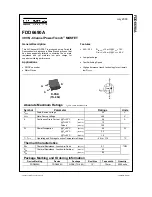
DATA ARITHMETIC LOGIC UNIT
MOTOROLA
DATA ARITHMETIC LOGIC UNIT
3 - 3
3.1
DATA ARITHMETIC LOGIC UNIT
This section describes the operation of the Data ALU registers and hardware. It dis-
cusses data representation, rounding, and saturation arithmetic used within the Data
ALU, and concludes with a discussion of the programming model.
3.2
OVERVIEW AND DATA ALU ARCHITECTURE
As described in Section 2, The DSP56K family central processing module is composed
of three execution units that operate in parallel. They are the Data ALU, address genera-
tion unit (AGU), and the program control unit (PCU) (see Figure 3-1). These three units
are register oriented rather than bus oriented and interface over the system buses with
memory and memory-mapped I/O devices.
The Data ALU (see Figure 3-2) is the first of these execution units to be presented. It bal-
ances speed with the capability to process signals that have a wide dynamic range and
performs all arithmetic and logical operations on data operands.
The Data ALU registers may be read or written over the XDB and the YDB as 24- or 48-
bit operands. The source operands for the Data ALU, which may be 24, 48, or 56 bits,
always originate from Data ALU registers. The results of all Data ALU operations are
stored in an accumulator.
The 24-bit data words provide 144 dB of dynamic range. This range is sufficient for most
real-world applications since the majority of data converters are 16 bits or less – and cer-
tainly not greater than 24 bits. The 56-bit accumulator inside the Data ALU provides 336
dB of internal dynamic range so that no loss of precision will occur due to intermediate
processing. Special circuitry handles data overflows and roundoff errors.
The Data ALU can perform any of the following operations in a single instruction cycle:
multiplication, multiply-accumulate with positive or negative accumulation, convergent
rounding, multiply-accumulate with positive or negative accumulation and convergent
rounding, addition, subtraction, a divide iteration, a normalization iteration, shifting, and
logical operations.
The components of the Data ALU are:
•
Four 24-bit input registers
•
A parallel, single-cycle, nonpipelined multiply-accumulator/logic unit (MAC)
•
Two 48-bit accumulator registers
•
Two 8-bit accumulator extension registers
•
An accumulator shifter
•
Two data bus shifter/limiter circuits
Summary of Contents for DSP56K
Page 12: ...xii LIST of TABLES MOTOROLA List of Tables Continued Table Page Number Title Number ...
Page 13: ...MOTOROLA DSP56K FAMILY INTRODUCTION 1 1 SECTION 1 DSP56K FAMILY INTRODUCTION ...
Page 31: ...MOTOROLA DATA ARITHMETIC LOGIC UNIT 3 1 SECTION 3 DATA ARITHMETIC LOGIC UNIT ...
Page 50: ...DATA ALU SUMMARY 3 20 DATA ARITHMETIC LOGIC UNIT MOTOROLA ...
Page 51: ...MOTOROLA ADDRESS GENERATION UNIT 4 1 SECTION 4 ADDRESS GENERATION UNIT ...
Page 77: ...MOTOROLA PROGRAM CONTROL UNIT 5 1 SECTION 5 PROGRAM CONTROL UNIT ...
Page 124: ...INSTRUCTION GROUPS 6 30 INSTRUCTION SET INTRODUCTION MOTOROLA ...
Page 125: ...MOTOROLA PROCESSING STATES 7 1 SECTION 7 PROCESSING STATES STOP WAIT EXCEPTION NORMAL RESET ...
Page 167: ...STOP PROCESSING STATE MOTOROLA PROCESSING STATES 7 43 ...
Page 168: ...STOP PROCESSING STATE 7 44 PROCESSING STATES MOTOROLA ...
Page 169: ...MOTOROLA PORT A 8 1 SECTION 8 PORT A ...
Page 176: ...PORT A INTERFACE 8 8 PORT A MOTOROLA ...
Page 177: ...MOTOROLA PLL CLOCK OSCILLATOR 9 1 SECTION 9 PLL CLOCK OSCILLATOR x x d Φ VCO ...
Page 191: ...10 2 ON CHIP EMULATION OnCE MOTOROLA SECTION 10 ON CHIP EMULATION OnCE ...
Page 218: ...USING THE OnCE MOTOROLA ON CHIP EMULATION OnCE 10 29 ...
Page 604: ...INSTRUCTION ENCODING A 338 INSTRUCTION SET DETAILS MOTOROLA ...
Page 605: ...MOTOROLA BENCHMARK PROGRAMS B 1 APPENDIX B BENCHMARK PROGRAMS T T T T T P1 P3 P2 P4 T T T ...
Page 609: ...BENCHMARK PROGRAMS MOTOROLA BENCHMARK PROGRAMS B 5 ...
Page 611: ...BENCHMARK PROGRAMS MOTOROLA BENCHMARK PROGRAMS B 7 ...
Page 613: ...BENCHMARK PROGRAMS MOTOROLA BENCHMARK PROGRAMS B 9 ...
Page 615: ...BENCHMARK PROGRAMS MOTOROLA BENCHMARK PROGRAMS B 11 ...















































